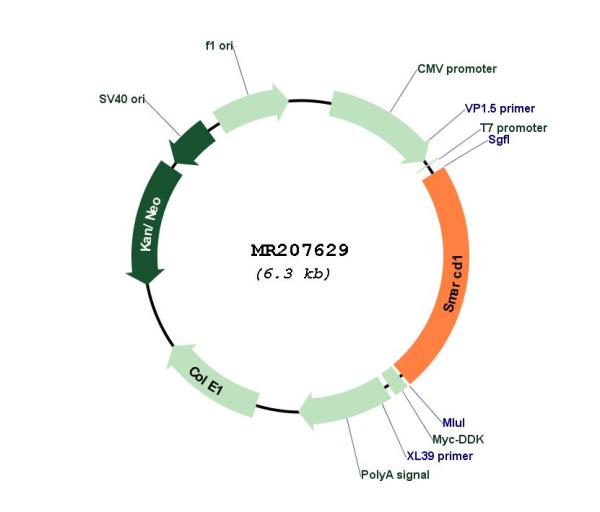Smarcd1 (BC026783) Mouse Tagged ORF Clone
CAT#: MR207629
- TrueORF®
Smarcd1 (Myc-DDK-tagged) - Mouse SWI/SNF related, matrix associated, actin dependent regulator of chromatin, subfamily d, member 1 (cDNA clone
ORF Plasmid: tGFP
Lentiviral Particles: DDK w/ Puro mGFP w/ Puro
AAV Particle: DDK
"BC026783" in other vectors (4)
Interest in protein/lysate? Submit request here!
USD 198.00
Specifications
| Product Data | |
| Type | Mouse Tagged ORF Clone |
| Tag | Myc-DDK |
| Symbol | Smarcd1 |
| Synonyms | AA407987; Baf60a; D15Kz1 |
| Vector | pCMV6-Entry |
| E. coli Selection | Kanamycin (25 ug/mL) |
| Mammalian Cell Selection | Neomycin |
| Sequence Data |
>MR207629 representing BC026783
Red=Cloning site Blue=ORF Green=Tags(s) TTTTGTAATACGACTCACTATAGGGCGGCCGGGAATTCGTCGACTGGATCCGGTACCGAGGAGATCTGCC GCCGCGATCGCC ATGGGCCCGGCGCCGGGTCAAGGGCTGTACCGCTCTCCGATGCCCGGGGCGGCCTATCCGAGACCAGGTA TGCTGCCAGGTAGCCGAATGACACCTCAGGGACCTTCCATGGGACCTCCTGGCTATGGGGGGAACCCTTC AGTCCGACCTGGTCTGGCCCAGTCAGGGATGGACCAGTCCCGCAAGAGACCTGCACCTCAACAGATCCAG CAGGTCCAGCAGCAGGCGGTCCAAAATCGAAATCACAATGCAAAGAAAAAGAAGATGGCTGACAAAATCC TACCTCAAAGGATTCGGGAACTGGTCCCAGAATCACAGGCCTACATGGATCTCCTGGCTTTTGAAAGGAA ACTGGACCAGACTATTATGAGGAAGCGGCTAGATATCCAGGAGGCCTTGAAACGTCCCATCAAGCAAAAA CGGAAGCTGCGAATTTTCATTTCTAACACGTTCAATCCGGCTAAGTCGGACGCGGAGGATGGGGAAGGGA CGGTGGCTTCCTGGGAGCTCCGGGTAGAAGGCCGGCTCCTGGAGGACGCGGCCTTGTCCAAATATGACGC CACCAAGCAAAAGAGAAAGTTCTCTTCCTTTTTTAAGTCCTTGGTGATCGAACTGGACAAAGACCTCTAT GGCCCAGACAACCATCTGGTAGAATGGCACAGGACCGCCACTACCCAGGAGACCGATGGCTTCCAGGTGA AGCGGCCAGGAGATGTGAATGTACGGTGTACTGTCCTGCTGATGCTGGACTACCAGCCCCCCCAGTTTAA ATTAGACCCTCGCCTGGCTCGGCTCTTGGGCATCCATACCCAGACACGTCCAGTGATCATCCAAGCACTG TGGCAGTATATTAAAACACACAAGCTCCAGGACCCTCACGAGCGAGAGTTTGTTCTCTGTGACAAGTACC TCCAGCAGATCTTTGAATCTCAGCGGATGAAGTTCTCAGAGATCCCTCAGCGGCTCCACGCCTTGCTTAT GCCACCAGAGCCCATCATCATCAATCATGTCATCAGTGTGGACCCAAATGACCAGAAAAAGACCGCGTGC TATGACATTGACGTGGAGGTGGATGACACTCTGAAGACCCAGATGAACTCTTTCCTGTTGTCCACTGCCA GCCAGCAGGAGATCGCCACTCTAGACAACAAGATCCATGAGACGATAGAGACCATCAACCAGCTGAAGAC CCAGCGAGAGTTCATGTTGAGCTTTGCCCGAGACCCTCAGGGTTTCATCAATGATTGGCTTCAGTCCCAG TGCAGGGACCTCAAGACGATGACTGATGTGGTGGGTAACCCGGAAGAGGAGCGTCGTGCTGAGTTCTACT TCCAGCCCTGGGCTCAGGAGGCTGTGTGCCGATACTTCTACTCCAAGGTGCAGCAGAGGCGGCAAGAGTT AGAGCAAGCCCTGGGAATCCGAAACACA ACGCGTACGCGGCCGCTCGAGCAGAAACTCATCTCAGAAGAGGATCTGGCAGCAAATGATATCCTGGATT ACAAGGATGACGACGATAAGGTTTAA >MR207629 representing BC026783
Red=Cloning site Green=Tags(s) MGPAPGQGLYRSPMPGAAYPRPGMLPGSRMTPQGPSMGPPGYGGNPSVRPGLAQSGMDQSRKRPAPQQIQ QVQQQAVQNRNHNAKKKKMADKILPQRIRELVPESQAYMDLLAFERKLDQTIMRKRLDIQEALKRPIKQK RKLRIFISNTFNPAKSDAEDGEGTVASWELRVEGRLLEDAALSKYDATKQKRKFSSFFKSLVIELDKDLY GPDNHLVEWHRTATTQETDGFQVKRPGDVNVRCTVLLMLDYQPPQFKLDPRLARLLGIHTQTRPVIIQAL WQYIKTHKLQDPHEREFVLCDKYLQQIFESQRMKFSEIPQRLHALLMPPEPIIINHVISVDPNDQKKTAC YDIDVEVDDTLKTQMNSFLLSTASQQEIATLDNKIHETIETINQLKTQREFMLSFARDPQGFINDWLQSQ CRDLKTMTDVVGNPEEERRAEFYFQPWAQEAVCRYFYSKVQQRRQELEQALGIRNT TRTRPLEQKLISEEDLAANDILDYKDDDDKV |
| Chromatograms |
CHROMATOGRAMS
 Sequencher program is needed, download here. |
| Restriction Sites |
SgfI-MluI
Cloning Scheme for this gene
Plasmid Map

|
| ACCN | BC026783 |
| ORF Size | 1428 bp |
| OTI Disclaimer | The molecular sequence of this clone aligns with the gene accession number as a point of reference only. However, individual transcript sequences of the same gene can differ through naturally occurring variations (e.g. polymorphisms), each with its own valid existence. This clone is substantially in agreement with the reference, but a complete review of all prevailing variants is recommended prior to use. More info |
| OTI Annotation | This clone was engineered to express the complete ORF with an expression tag. Expression varies depending on the nature of the gene. |
| Product Components | The ORF clone is ion-exchange column purified and shipped in a 2D barcoded Matrix tube containing 10ug of transfection-ready, dried plasmid DNA (reconstitute with 100 ul of water). |
| Reconstitution | 1. Centrifuge at 5,000xg for 5min. 2. Carefully open the tube and add 100ul of sterile water to dissolve the DNA. 3. Close the tube and incubate for 10 minutes at room temperature. 4. Briefly vortex the tube and then do a quick spin (less than 5000xg) to concentrate the liquid at the bottom. 5. Store the suspended plasmid at -20°C. The DNA is stable for at least one year from date of shipping when stored at -20°C. |
| Reference Data | |
| RefSeq | BC026783.1 |
| RefSeq Size | 3086 bp |
| RefSeq ORF | 1430 bp |
| Locus ID | 83797 |
| Cytogenetics | 15 56.13 cM |
| MW | 113.1 kDa |
| Gene Summary | Involved in transcriptional activation and repression of select genes by chromatin remodeling (alteration of DNA-nucleosome topology). Component of SWI/SNF chromatin remodeling complexes that carry out key enzymatic activities, changing chromatin structure by altering DNA-histone contacts within a nucleosome in an ATP-dependent manner (By similarity). Belongs to the neural progenitors-specific chromatin remodeling complex (npBAF complex) and the neuron-specific chromatin remodeling complex (nBAF complex). During neural development a switch from a stem/progenitor to a postmitotic chromatin remodeling mechanism occurs as neurons exit the cell cycle and become committed to their adult state. The transition from proliferating neural stem/progenitor cells to postmitotic neurons requires a switch in subunit composition of the npBAF and nBAF complexes. As neural progenitors exit mitosis and differentiate into neurons, npBAF complexes which contain ACTL6A/BAF53A and PHF10/BAF45A, are exchanged for homologous alternative ACTL6B/BAF53B and DPF1/BAF45B or DPF3/BAF45C subunits in neuron-specific complexes (nBAF). The npBAF complex is essential for the self-renewal/proliferative capacity of the multipotent neural stem cells. The nBAF complex along with CREST plays a role regulating the activity of genes essential for dendrite growth (PubMed:17640523). Has a strong influence on vitamin D-mediated transcriptional activity from an enhancer vitamin D receptor element (VDRE). May be a link between mammalian SWI-SNF-like chromatin remodeling complexes and the vitamin D receptor (VDR) heterodimer. Mediates critical interactions between nuclear receptors and the BRG1/SMARCA4 chromatin-remodeling complex for transactivation (By similarity).[UniProtKB/Swiss-Prot Function] |
Documents
| Product Manuals |
| FAQs |
| SDS |
Resources
Other Versions
| SKU | Description | Size | Price |
|---|---|---|---|
| MC218507 | Smarcd1 (untagged) - Mouse SWI/SNF related, matrix associated, actin dependent regulator of chromatin, subfamily d, member 1 (cDNA clone, (10ug) |
USD 503.00 |
|
| MG207629 | Smarcd1 (tGFP-tagged) - Mouse SWI/SNF related, matrix associated, actin dependent regulator of chromatin, subfamily d, member 1 (cDNA clone |
USD 657.00 |
|
| MR207629L3 | Lenti ORF clone of Smarcd1 (Myc-DDK-tagged) - Mouse SWI/SNF related, matrix associated, actin dependent regulator of chromatin, subfamily d, member 1 (cDNA clone |
USD 757.00 |
|
| MR207629L4 | Lenti ORF clone of Smarcd1 (mGFP-tagged) - Mouse SWI/SNF related, matrix associated, actin dependent regulator of chromatin, subfamily d, member 1 (cDNA clone |
USD 757.00 |
{0} Product Review(s)
Be the first one to submit a review






























































































































































































































































 Germany
Germany
 Japan
Japan
 United Kingdom
United Kingdom
 China
China


